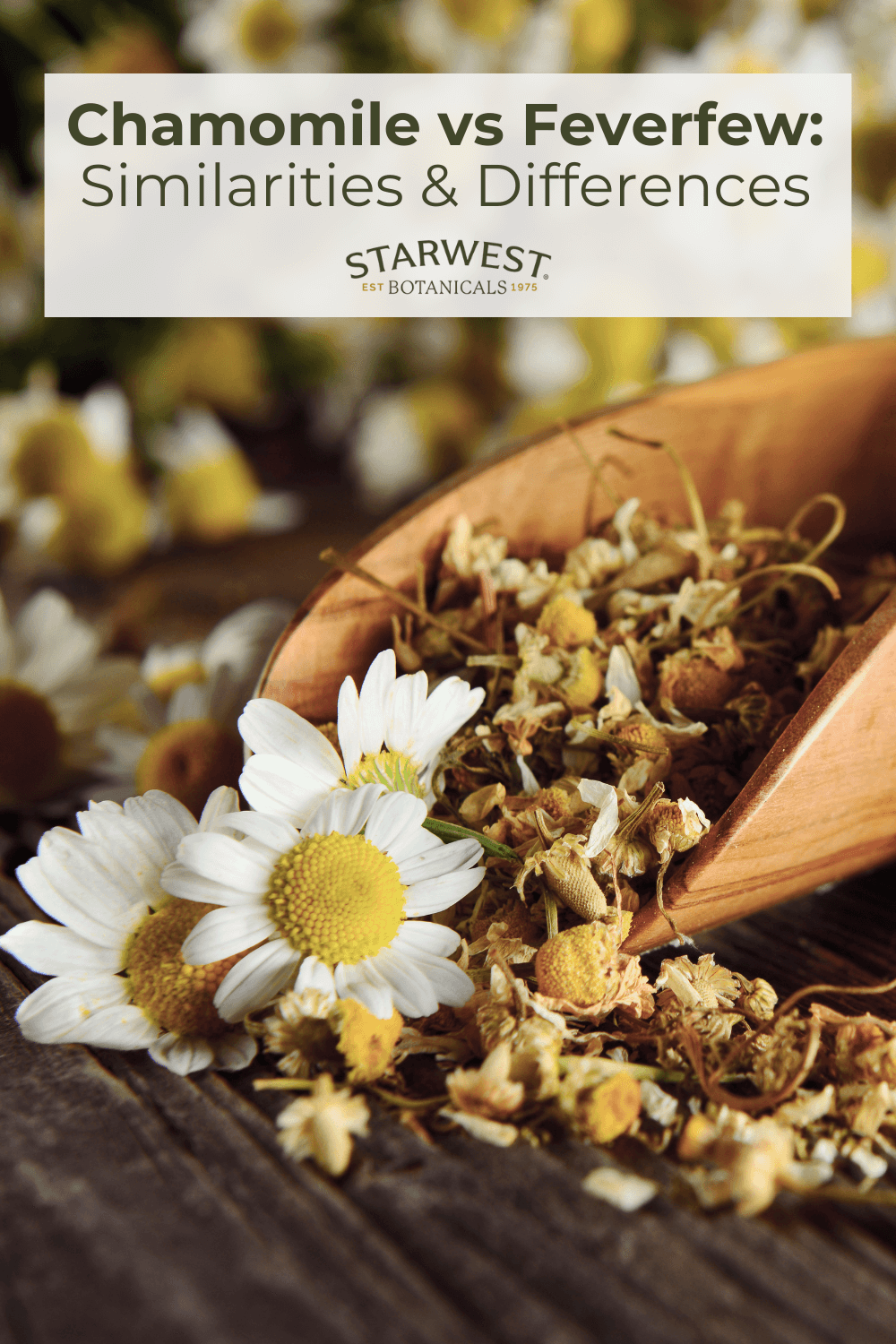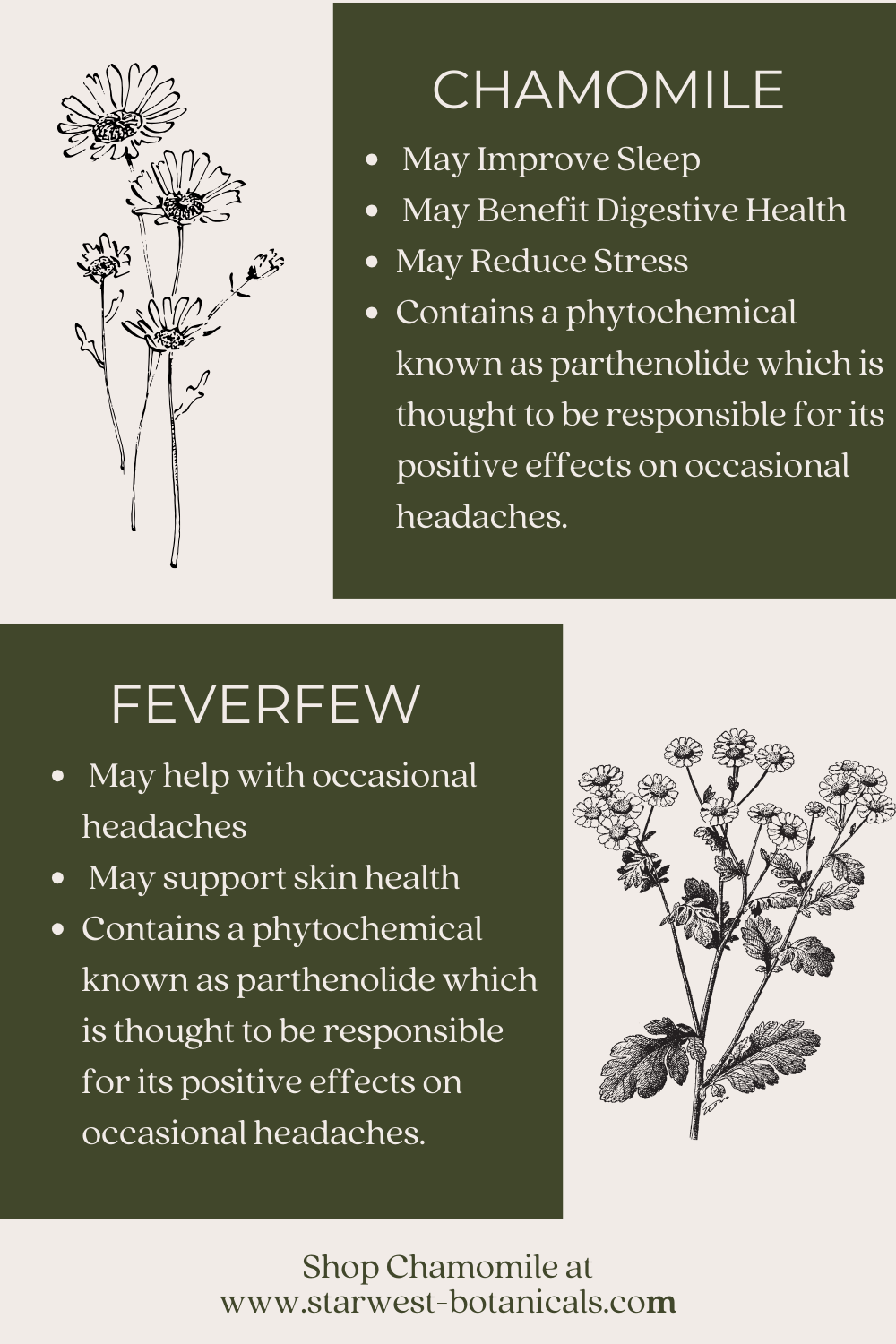Chamomile vs Feverfew: Similarities & Differences | Starwest Botanicals
Posted by Daniel Powers on 09-11-2023

Chamomile and feverfew are two well-known herbs often linked together due to their similar appearance and health benefits.
German chamomile is a popular herb that’s used as a soothing bedtime tea, known for promoting relaxation and aiding sleep. Additionally, it is highly regarded for its beneficial effects on digestive health. Feverfew on the other hand is commonly used for migraines.
Prior to selecting an herb for purchase, it is essential to understand the crucial differences between these two botanicals. At Starwest Botanicals we sell a wide variety of both Feverfew and Chamomile products.
In this article, we’ll dig into the differences between German chamomile and feverfew, as well as their similarities, in this article.
German Chamomile Overview & Uses:
Scientifically known as Matricaria recutita, German chamomile has been revered for countless centuries for its multitude of health benefits.
According to traditional herbal medicine accounts, German chamomile is thought to possess calming properties.
When brewed into tea, chamomile has been used to improve sleep quality, may induce mental relaxation, and promote a healthy digestive system. Moreover, German chamomile has also been incorporated into various balms and salves to support the natural healing process of wounds.
1. Improved Sleep
Getting adequate sleep is vital for both physical and mental health. Chamomile is widely acknowledged as a dependable natural remedy for sleep.
In a clinical trial, it was discovered that consuming German chamomile tea contributes to improved sleep quality. Remarkably, the researchers observed that the effects of chamomile were noticeable within a two-week timeframe.
Another study revealed that taking a chamomile supplement improved sleep quality among elderly individuals. The researchers observed that chamomile appeared to reduce the time it takes to fall asleep, and enhanced overall sleep quality.
2. Reduced Stress
We all experience mental stress at times. Incorporating natural calming herbs such as German chamomile into our routine is essential for maintaining balance, even during chaotic periods in life.
Clinical research shows that chamomile may help to reduce stress. Taking a chamomile supplement has been found to significantly lower stress, with few reported side effects, indicating its long-term safety.
3. Improved Digestive Health
Maintaining a healthy digestive system is crucial for overall health and well-being. A well-functioning digestive system allows for the proper absorption of nutrients, supports immune function, and contributes to optimal physical and mental functioning.
Chamomile has a long history of use in traditional herbal medicine for its potential to alleviate digestive complaints. It has been traditionally believed to help reduce gastrointestinal discomfort and bloating.
Supporting this traditional knowledge, a study conducted on mice found that chamomile may have a relaxing effect on the digestive system. This research suggests that chamomile may indeed possess properties that promote digestive relaxation and potentially contribute to improved overall digestion.
Feverfew Overview & Uses:
Feverfew is known scientifically as Tanacetum parthenium. This herb is native to parts of Eastern Europe and Asia, but it can now be found growing all around the world.
Traditionally, feverfew was used to help with fevers and headaches. This is in line with the current use of feverfew.
1. May Help with Occasional Headaches
Headaches are common and cause pain in the head or face. They negatively affect us by causing discomfort, reducing focus, productivity, and overall well-being. Managing headaches is important for our health and quality of life.
Feverfew was traditionally used to help with migraines and headaches.
Studies have shown that using feverfew can be beneficial for occasional headaches. In a survey of 270 people with migraines, over 70 percent reported feeling much better after using an average of two to three fresh feverfew leaves daily. This suggests that feverfew could be a helpful natural remedy.
Another study found that a combination of feverfew and white willow bark was also effective. People who took this combination experienced fewer migraines, with less intense and shorter-lasting pain. This suggests that using feverfew and white willow bark together may be helpful in managing occasional migraines.
2. Skin Health
Maintaining healthy skin is key for looking, and feeling your best.
Feverfew has been found to have positive effects on skin health. Research suggests that feverfew extracts, especially those without parthenolide, are responsible for this protective effect. This makes feverfew a potentially effective and safe option for improving skin health.

Feverfew vs German Chamomile: Similarities & Differences
When it comes to comparing feverfew versus German chamomile, there are a few key similarities and differences to keep in mind.
From a botany perspective, feverfew looks similar to chamomile in that it has a yellow center and small white flowers, however, it has wider leaves that resemble parsley.
As far as similarities go, both German chamomile and feverfew have similar effects in that they help to support healthy skin. Additionally, these herbs have a similar appearance, which can be confusing when you see both herbs growing out in the wild.
That said, there are differences between feverfew and chamomile. This is mainly seen in their differing phytochemical profiles.
Feverfew contains a phytochemical known as parthenolide which is thought to be responsible for its positive effects on occasional headaches.
On the other hand, German chamomile contains chamazulene as one of its primary constituents. This phytochemical, which gives chamomile essential oil its blue color, is thought to be responsible for its skin-soothing benefits.
While feverfew has more of a focused benefit profile, chamomile is more wide spectrum, with a variety of health benefits.
Feverfew vs Chamomile: Which Is Right For You?
While both feverfew and chamomile have various health benefits, one may be more effective for you (and vice versa)
If you’re looking to support digestive health and improve your sleep, then chamomile is a great option. It’s fantastic when taken as a bedtime tea. As an added bonus, this herb is also helpful for wound healing. It can also help with restoring mental calm.
At Starwest Botanicals, we carry a large variety of chamomile products, including:
- Chamomile Flowers
- Organic Chamomile Flowers
- Organic Chamomile Flowers (Egypt)
- Chamomile Flower Extract
- And Chamomile Essential Oil
Feverfew is a natural herb for those that are looking for help with occasional migraines. It can be taken as great tasting tea. We sell an organic feverfew herb here that’s perfect for tea.
Conclusion:
Both chamomile and feverfew are effective herbs with a variety of benefits.
Depending on your needs, you may discover that one is superior to the other, or vice versa! Alternatively, combine them to see whether you get a synergistic effect.
At Starwest Botanicals, we have a variety of different types of chamomile and feverfew available for purchase, including:
- Chamomile Flowers
- Organic Chamomile Flowers
- Chamomile Flower Extract
- Chamomile Essential Oil
- And Organic Feverfew
Daniel has a master's degree in herbal science from the Maryland University of Integrative Health. He's the founder of The Botanical Institute, where he writes about the health benefits of herbs.



